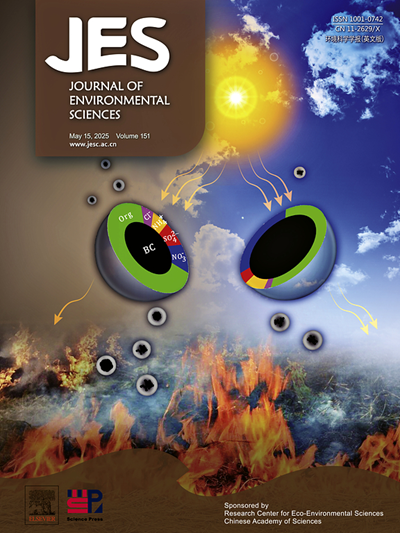淡水大型植物类型(大型藻类与显生藻类)主要决定碎屑衍生温室气体的产生:一个微观实验
IF 5.9
2区 环境科学与生态学
Q1 ENVIRONMENTAL SCIENCES
引用次数: 0
摘要
淡水生态系统对全球温室气体(如甲烷)的排放至关重要。大型植物是这些系统沉积物的主要有机质(即碎屑)供给者,从而控制CH4的产生。然而,物种特异性差异(结构和组成)可能决定了碎屑转化为CH4的不同模式。此外,富营养化可以影响降解,从而影响CH4的产生。我们进行了为期64天的微观实验,在两种营养条件下(贫营养化与富营养化)和有无沉积物的条件下,对7种不同系统发育的大型植物(两种绿叶植物,丝状藻类-丝绵藻,Cladophora -,三种水下植物和一种两栖植物)的碎屑进行缺氧培养。在实验结束时,我们评估了CH4和CO2的产量以及碎屑质量的变化。平均累积CH4产生量排名依次为:紫菜;透明Nitella hyalina;Najas marina≈Teucrium scordium >;果盘菌≈细棘肉豆蔻菌>;丝状藻类,并与碎屑质有关。温室气体最大产率分别为1.6 (N. marina) ~ 1.2 (C. hispida) mmol CH4/(g OC·d)和1.7 (N. marina) ~ 1.5 (C. hispida) mmol CO2/(g OC·d)。CO2:CH4比值在前10天(平均为200)向CO2倾斜,随后下降至1左右。沉积物有利于碎屑分解(可能是由于“正启动效应”),增加了温室气体的产生。营养物富集对其影响不明显。研究大型植物碎屑与温室气体产生的关系是预测大型植物主导系统温室气体排放的必要条件。本文章由计算机程序翻译,如有差异,请以英文原文为准。
Freshwater macrophyte type (macroalgae versus phanerogams) mainly determines detritus-derived greenhouse gases production: A microcosm experiment
Freshwater ecosystems are crucial in the global emissions of greenhouse gases (GHGs) such as CH4. Macrophytes are the main organic matter (i.e., detritus) supplier to the sediment of these systems, thus controlling CH4 production. However, species-specific differences (structure and composition) may determine contrasting patterns of detritus transformation into CH4. Furthermore, eutrophication can affect the degradation and, consequently, CH4 production. We performed a 64-day microcosm experiment with anoxic incubations of detritus from seven phylogenetically different macrophytes (two charophytes, filamentous algae –Spirogyra, Cladophora–, three submerged plants and an amphibious one), under two trophic conditions (oligo- versus eutrophic) and with/without sediment. We assessed the CH4 and CO2 production and the changes in the detritus quality at the end of the experiment. The ranking in the mean cumulative CH4 production was: Chara hispida > Nitella hyalina > Najas marina ≈ Teucrium scordium > Stuckenia pectinata ≈ Myriophyllum spicatum > filamentous algae, and it was related to the detritus quality. GHGs maximum production rates were 1.6 (N. marina)-1.2 (C. hispida) mmol CH4/(g OC·day) and 1.7 (N. marina)-1.5 (C. hispida) mmol CO2/(g OC·day). The CO2:CH4 ratio was biased towards CO2 during the first 10 days (average ratio of 200) and fell afterwards to about 1 for all macrophyte species and treatments. The sediment favored detritus decomposition (probably due to the “positive priming effect”), increasing GHGs production. The influence of nutrient enrichment was not evident. Delving into the macrophyte detritus quality-GHGs production relationship is needed to forecast the GHGs emissions in macrophyte-dominated systems.
求助全文
通过发布文献求助,成功后即可免费获取论文全文。
去求助
来源期刊

Journal of Environmental Sciences-china
环境科学-环境科学
CiteScore
13.70
自引率
0.00%
发文量
6354
审稿时长
2.6 months
期刊介绍:
The Journal of Environmental Sciences is an international journal started in 1989. The journal is devoted to publish original, peer-reviewed research papers on main aspects of environmental sciences, such as environmental chemistry, environmental biology, ecology, geosciences and environmental physics. Appropriate subjects include basic and applied research on atmospheric, terrestrial and aquatic environments, pollution control and abatement technology, conservation of natural resources, environmental health and toxicology. Announcements of international environmental science meetings and other recent information are also included.
 求助内容:
求助内容: 应助结果提醒方式:
应助结果提醒方式:


